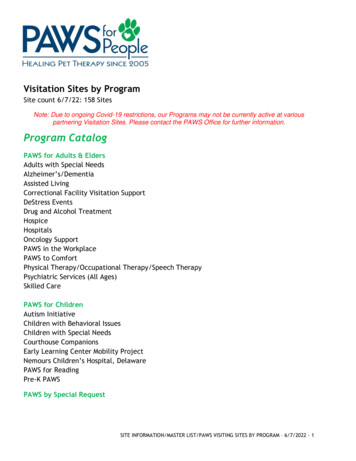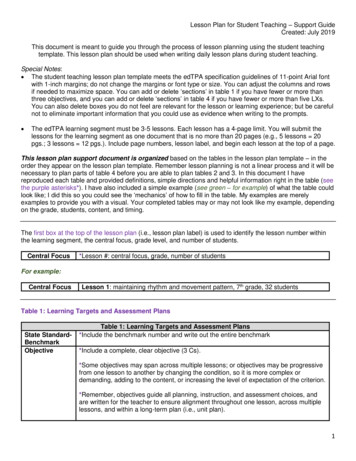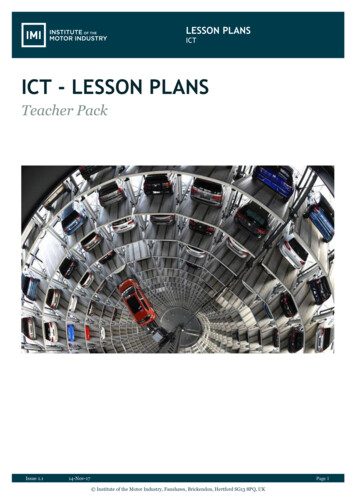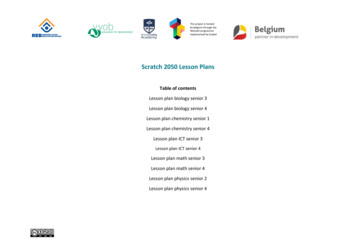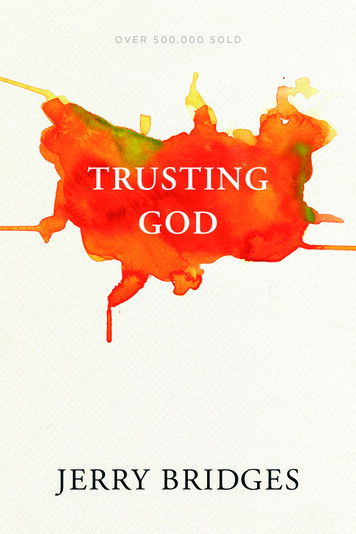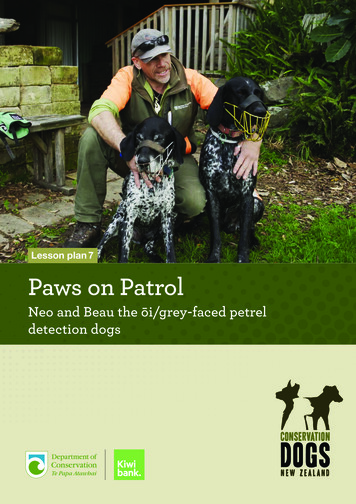
Transcription
Lesson plan 7Paws on PatrolNeo and Beau the ōi/grey-faced petreldetection dogs
KEY links to videos links to websites links to pages within this resourceLearning intentionsKey vocabularyThis lesson plan has been developed to supportlearning about the Conservation Dogs Programmeand our native ōi/grey-faced petrel. It should becompleted after viewing Paws on Patrol episode 7:Andy, Neo and Beau in the Fanimals series.Biodiversity: The variety of living things in a place.The greater the number of living things, the more‘biodiverse’ the place is.Biosecurity: Actions to keep New Zealand free ofunwanted organisms (introduced predators, weedsand diseases such as kauri dieback and myrtle rust)and to control, manage or remove them if they arrivein the country.To learn more about Conservation Dogs, Predator Free2050, biosecurity and how to take conservation actionin your local community, visit : A hole or tunnel that is dug by a small animalto serve as a dwelling.Upon completion of this lesson plan, students will beable to understand: GPS: Global Positioning System. This is a radionavigation system that allows users to determinetheir exact location in all weather conditions and fromanywhere in the world.t he important role Conservation Dogs play inprotecting New Zealand’s unique biodiversity that seabirds such as the ōi/grey-faced petrel areunique to New Zealand and have special features,behaviours and adaptations some of the threats our seabirds face and what we cando to protect them.Habitat: The natural home or environment of ananimal, plant or other organism.Headland: A narrow piece of land that projects froma coastline into the sea.Introduced pest/predator: An animal or plant speciesthat has come from another country and is threateningNew Zealand’s living things and environment.Introduced predators were brought to New Zealandby people via ships and through the transportationof goods.Curriculum linksAchievement objectivesLEVELS 1–4 SCIENCENature of Science: Investigating in science,Communicating in science, Understandingabout science, Participating and contributing.Muttonbird: A member of the petrel family ofseabirds. These birds have dark brown plumage withsilvery-white markings under the wings. Living World: Ecology. Recognise (and explain)how living things are suited to their particularhabitat and how they respond to environmentalchanges, both natural and human-induced.Prospecting: Searching for or seeking.Sanctuary: A protected area that is isolated byfencing, geographical features or, more commonly, theintensive management of introduced predators/peststo keep wildlife safe.Science capabilities: Engage with science.LEVELS 1–4 SOCIAL STUDIESUnderstand how people view and use placesdifferentlyUnderstand how people make decisions aboutaccess to and use of resources.Key competencies Thinking. Use of language. Relating to others. Participation and contribution. 2
Activity ideasActivity 3: Conduct your own research into howgrey-faced petrels are the same as or different fromother seabirds (in particular, consider their breedinghabitat). The links listed in the ‘Supporting resources’section below could help with your research. SeeActivity 4 in the Tāiko/black petrel and otherseabirds education resource (pages 24–28) for ideas onhow to record and share your research findings.Activity 1: WatchPaws on Patrol episode 7 andhave a class discussion to summarise the story. Thenwatch the video a second time and ask students tothink about the three key points in the story. They canthen share these points with a buddy and compareideas. You could ask students the following questionsto support the discussion. Activity 4: Identify some of the major threats toseabirds by considering the following questions.What characteristics or qualities do Neo and Beauhave that make them suited to detecting protectedspecies?How do trained Conservation Dogs benefit theenvironment and conservation?What can you do at school or in your own backyardto protect and restore nature? Activity 2: Discuss prior knowledge and experiencesof seabirds. This could be through a group discussionor paired conversations. Play ‘Seabird bingo’ to encourage furtherdiscussion. Students can have brief conversationswith others to find people who have had theexperiences listed. They can then record theirnames and tick the appropriate squares until theyhave completed the grid.Use the ‘Recording knowledge’ activity sheetto record prior knowledge and any questions.(If students are having difficulty thinking of whatthey already know, ask them which pictures andwords come to mind and where this knowledgecame from, eg a person/place/experience.)NB: The drawings are about recording knowledge,not demonstrating artistic skills.What is a threat? Encourage students to have aquick chat about what they understand a threat tobe and then share ideas.Will threats be the same for every species ofseabird? The main threats to a particular specieswill depend on a variety of factors, such as itsbehaviours, habitat and life cycle.What kinds of threats did people bring to NewZealand? Ask students to consider this and thenshare ideas through ‘think–pair–share’, ‘walk–pair–share’ or a talking doughnut activity.Once you have investigated a variety of threats, createa mind-map of the threats that affect seabirds using adigital tool such as popplet.com or coggle.it.Activity 5: Brainstorm and record ideas about what asafe habitat for seabirds would look like. Ōi/grey-faced petrel. Photo: Terry C. GreeneFun factDid you know that New Zealand is known asthe ‘seabird capital of the world’? We have themost diverse seabird community in the world,comprising albatrosses, petrels, penguins,shags, gannets, gulls, terns and skuas.3Students could begin to record their ideas aboutsafe seabird habitat by creating a wall mural,artwork or a digital presentation. The artworkcould reflect an example of seabird habitat ina protected environment or reserve (eg ŌhiwaHeadland Sanctuary).Students could continue to add ideas to theirdisplay/presentation about why sanctuaries ormanaged areas are often necessary for seabirdsurvival and how different people have beeninvolved in establishing them. Use various sourcesof information and include both text and images torepresent these ideas.Students can find information about how groupsaround New Zealand are restoring seabird habitatsby following the links in the ‘Supportingresources’ section below.
Activity 6: It’s time to take action for seabirds! An action should make a difference for a focusissue and contribute to the best future you canimagine. Issues could include plastics in theocean, climate change, introduced predators inisland sanctuaries (eg Ōhiwa Headland Sanctuary)or another issue that is relevant to your localcommunity.See the ‘Supporting resources’ section below foraction ideas.See Activity 11: Action for marine environmentsfrom DOC’s Protecting our marine world educationresource for guidance on planning, carrying outand monitoring your chosen actions. Supporting resourcesUseful links Ōi/grey-faced petrel and other seabirds New Zealand birds online: relTāiko/black petrel and other seabirds educationresource: www.doc.govt.nz/education-taikoThis inquiry unit introduces students to the tāiko/black petrel and then extends their learning inquiryto investigate and research tākapu/gannets, kororā/little blue penguins and tarāpunga/red-billed gulls.Observing a royal albatross/toroa ssThis resource outlines activities to support studentsin viewing the ‘royal cam’ (a camera set up at atoroa/royal albatross nest at Taiaroa Head nearDunedin.Seabirds factsheets: ther informationFor additional resources to support teaching andlearning in nature, visit DOC’s conservation educationwebpage: www.doc.govt.nz/education.To learn more about our amazing Conservation Dogs,check out DOC’s Conservation Dogs Programmeeducation resource at www.doc.govt.nz/educationconservation-dogs.For further information on the ConservationDogs Programme, visit www.doc.govt.nz/conservation-dogs.Marine conservation and environmental actions toprotect seabirds Learn about how students at Wainui Beach Schoolmade nesting boxes to help protect their locallittle blue penguins. n about how students on Great Barrier Island(Aotea Island) have been cleaning up their beaches,analysing the rubbish they find and creating artfrom it. p-our-islands-cleanBlue the film: https://bluethefilm.org/takeactionProvides ideas on how to take action to protect yourlocal marine environment.Love your coast website: www.loveyourcoast.org.nz/learnProvides information about the impact of rubbishon our marine environments and support forplanning your own clean up event.Experiencing Marine Reserves akiaction-projectsLearn about the action projects that are beingundertaken by schools taking part in theExperiencing Marine Reserves programme.Ōhiwa Headland Sanctuary: www.facebook.com/OhiwaHeadlandSanctuaryProtecting our marine world education ldUse this inquiry unit to learn about, experience andprotect a local marine environment.These lesson plans have been written by Whitebait Media, with support from the Department of Conservation. June 2020Editing and design: Te Rōpū Ratonga Auaha, Te Papa Atawhai Creative Services, Department of Conservation4T34065
Sea bird bingoFind someone who:Has heard ofōi/grey-facedpetrelsHas seen a birddiving intothe seaCan spell ‘petrel’Can tell yousomething aboutōi/grey-facedpetrelsName: Name: Name: Can explain whata seabird isHas visited anisland whereseabirds liveCan nameanother seabirdHas seen an ōi/grey-faced petrelor a similar birdName: Name: Name: Name: Has been in aforestCan tell youwhere you mightsee an ōi/greyfaced petresName: Name: Name: Can tell you theHas seen a bird’sMāori name forburrow (or nest)grey-faced petrelName: Sea bird bingo5Name:
Recording knowledgeName:Date:-What I already know aboutoi/grey faced petrels:What would I like to find outabout oi/grey faced petrels? My picture of an oi/grey faced petrel (with labels)Recording knowledge6
Prospecting: Searching for or seeking. Sanctuary: A protected area that is isolated by fencing, geographical features or, more commonly, the intensive management of introduced predators/pests to keep wildlife safe. KEY links to videos links to websites links to pages within this resource Achievement objectives LEVELS 1-4 SCIENCE

